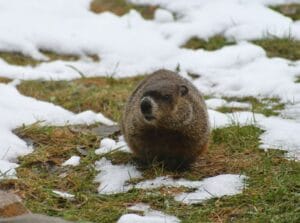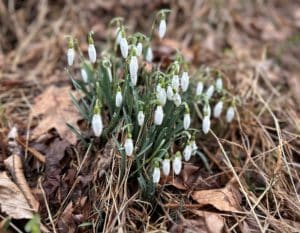Hello, fellow lovers of all things green. The ancient origin of Groundhog Day dates back thousands of years, and while its success in predicting winter’s end is marginally accurate, it’s a fun tradition that celebrates nature. At about 7:25 a.m. this morning, Punxsutawney Phil saw his shadow, which predicts we will have six more weeks of winter. As the folklore goes, it would be early spring if he didn’t.

Jolee, in 2021, didn’t see her shadow (smile).

The day after Groundhog Day, her shadow returned.
The Ancient Origin of Groundhog Day
Officially, the first Groundhog Day celebration occurred on February 2nd, 1887, in Punxsutawney, Pennsylvania. But Groundhog Day stems back thousands of years when, in the portion of Europe now Germany, badgers (some sources say hedgehogs) were thought to anticipate the coming spring, indicating when farmers should plant crops. When Germans immigrated to America and established themselves in Pennsylvania, where badgers and hedgehogs are not native, groundhogs became the go-to.
It hadn’t occurred to me that Groundhog Day, always February 2nd, is typically the midpoint of the first day of winter, the winter solstice, and the first day of spring, the spring equinox. And it’s halfway between the summer solstice and the autumnal equinox in the Southern Hemisphere. Perhaps the reason for the date? Humm…

Miss Ellie Mae in 2019 -No Shadow to be seen.
Famous groundhogs of Groundhog Day
Groundhogs (Marmota monax), also called woodchucks, live two to three years on average but can live up to six years in the wild. Those in captivity can live longer. But according to the Punxsutawney Groundhog Club, Phil has extraordinary powers. He continues to live since his first spring prediction in 1886, a year before the celebration became official, thanks to a secret “elixir of life” he sips every summer to give him seven more years.
There are other famous groundhogs besides the Phil. Two popular fellas are Shubenacadie Sam of Nova Scotia, Canada, and Beau (short for General Beauregard) of the National Weather Service near Atlanta. While chatting with Koleen, my writer friend who lives in Canada (you may recall Koleen’s Hilarious Dagnabbit Rabbit Dilemma) – she told me about Wiarton Willie, an albino groundhog who is the star of the show at the Wiarton Willie Festival in Wiarton, Ontario, a tradition that began in 1956. The history of the Wiarton Willie Festival is entertaining.
Origin of the Wiarton Willie Festival

Groundhog Photo by Ralph Katieb on Unsplash
Mac McKenzie wanted to showcase his childhood home and sent invitations to his friends for a “Groundhog Day” gathering. Somehow, a Toronto Star Reporter found an invitation and tracked down the occasion, which turned out to be a party at a local pub. To save face, the reporter asked that McKenzie create an event he could report. So McKenzie staged one by digging a hole in the snow donning his wife’s fur hat with hefty buttons, a photo of which ran in the February 3rd, 1956 edition of the Toronto Star, and the tradition grew from there.
Perhaps the most famous groundhog in America next to Punxsutawney Phil is Chuck at the Staten Island Zoo. Maybe Chuck came to fame when he bit Mayor Bloomberg in the 2009 festivities. Or was it when Mayor de Blasio dropped “Chuck” in 2014? Chuck was a stand-in; her real name was Charlotte, who died a few days later. I don’t believe the tradition of a mayor participating in Groundhog Day at the Staten Island Zoo hasn’t happened since.
So Why is Groundhog Day always on February 2nd?
According to the Punxsutawney Groundhog Club, it relates to Candlemas Day, a Christian Holiday held on February 2nd, when Christians celebrate the first bringing of baby Jesus to the Temple of Jerusalem to welcome him into Judaism. Traditions of blessing candles, symbolizing Jesus Christ as the Light of the World, continue in many religions. According to German folklore, Candlemas Day coincided with whether or not the hedgehog saw his shadow. Snowdrops (Galanthus), those lovely little nodding white flowers that magically emerge through the last layer of winter’s frosting, are also known as Candlemas Bells, representing Jesus bringing hope to the world.

Snowdrops, known as Candlemas Bells, are featured on Candlemas Day, representing hope.
The Accuracy of Groundhog Day
Of course, we know about the famous movie Groundhog Day (1993), which gave the words a new significance as something that endlessly repeats. One exciting repetitive task in anticipation of spring is purchasing seeds.
Early shopping is best as more and more folks have discovered the joy of digging in the dirt and growing non-GMO and organic food. Most seed packs have an abundance of seeds. So, share them graciously. Seeds, like spring, represent the promise of new beginnings. And by sharing the promise, you’ll be spreading hope.
The thing is, Punxsutawney Phil is more often wrong than accurate reports LiveScience.com. “Data from the Stormfax Almanac’s data shows that Phil’s six-week prognostications have been correct about 39% of the time, so less than chance.” Still, Groundhog Day is a fun tradition, and spring is something to celebrate whenever it comes. Though not so much the garden damage caused by groundhogs, as cute as they can be.
Garden Dilemmas? AskMaryStone@gmail.com and your favorite Podcast App.
Enjoy more of the story in the Garden Dilemmas Podcast (a soothing 10 minutes):
Enjoy a previous column, Groundhog or Woodchuck Dilemma?
And a column featuring Snowdrops.


